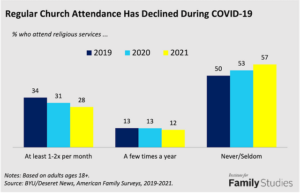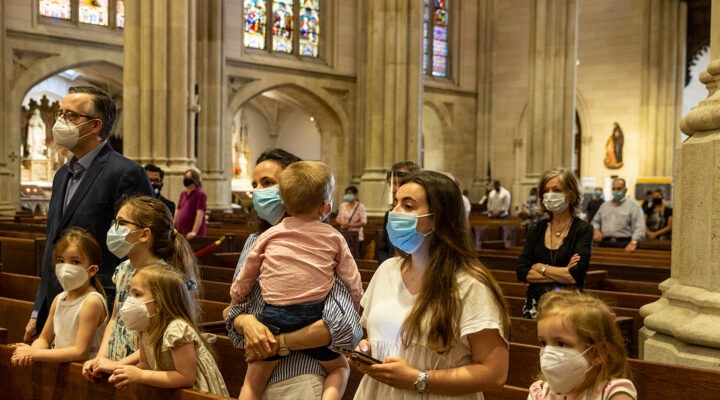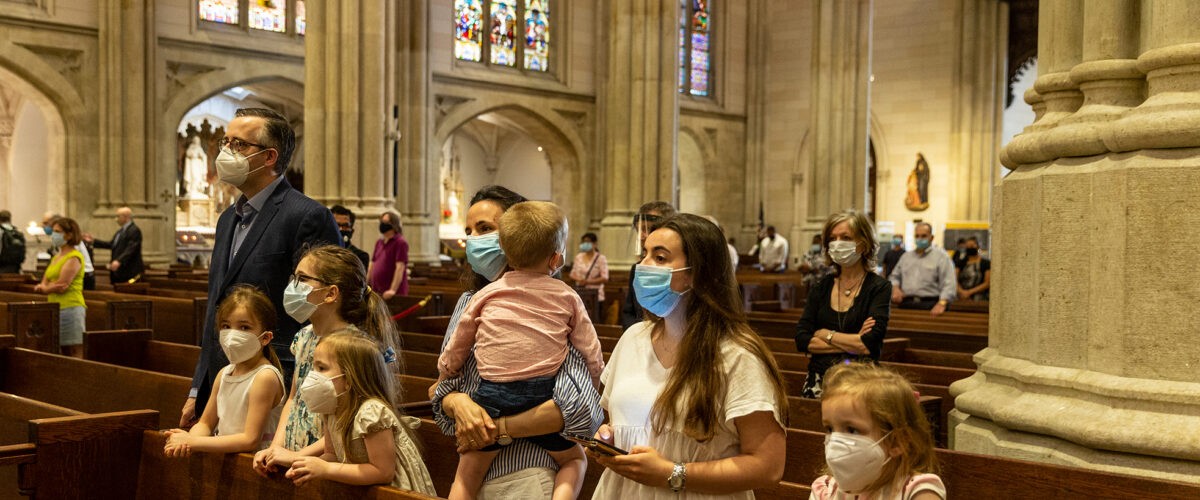Yes, church attendance has declined in the two years of the pandemic. But it has not declined equally across all demographic groups, according to a new analysis published by the Institute for Family Studies.
The Institute sifted through data from Barna Research, Gallup and the American Family Survey.
“According to data collected in April/May 2020 by Barna Group, one in three practicing Christians dropped out of church completely during COVID-19,” the Institute’s Wendy Wang reported. “Last June, the AP broke a story about many houses of worship in the U.S. that were shuttered forever due to the pandemic. What’s worse, church membership in the U.S. dropped below 50% for the first time in 2020, according to Gallup data dating back to 1940.”
 An analysis of the American Family Survey shows the percentage of Americans who are regular churchgoers has dropped 6 percentage points, from 34% in 2019 to 28% in 2021. In the same period, the share of secular Americans who never or seldom attend religious services increased by 7 percentage points.
An analysis of the American Family Survey shows the percentage of Americans who are regular churchgoers has dropped 6 percentage points, from 34% in 2019 to 28% in 2021. In the same period, the share of secular Americans who never or seldom attend religious services increased by 7 percentage points.
The American Family Survey — which is a collaboration among the Center for the Study of Elections and Democracy, the Deseret News and YouGov — measures religious attendance in a standard way with this question: “Aside from wedding and funerals, how often do you attend religious services?”
Outliers in answering this question are both younger and older Americans — the two groups most likely to have shifted to less-frequent attendance.
“The decline is about 10 percentage points between 2019 and 2021 for those under age 35 as well as for those 65-plus, but only 4 percentage points for the middle-aged group,” the Institute found. “Black Americans are also more likely than others to see a sharp decline in church attendance. In 2019, 45% of Black Americans attended religious service regularly. By 2021, the share dropped to 30%, a difference of 15 percentage points. The decline in other racial/ethnical groups is between 5 to 6 percentage points.”
In 2019, 45% of Black Americans attended religious service regularly. By 2021, the share dropped to 30%.
However, the decline in church attendance is most profound among married adults without children under age 18. In 2019, about 40% of that group attended church regularly. By 2021, church attendance among this group had dropped 10 points, to 30%.
And contrary to what some have speculated, the decline in church attendance has been proportionate across the ideological spectrum, the Institute found. “Conservatives are more likely than moderates and liberals to attend religious services in the first place, but the decline in attendance is similar in the three groups. Likewise, no significant differences by income are found in the decline of religious service attendance in the past two years.”
 The next question is whether this dip in attendance will rebound. If history is any indicator, it will not, the Institute reported, citing data from the Great Recession of 2007 to 2009.
The next question is whether this dip in attendance will rebound. If history is any indicator, it will not, the Institute reported, citing data from the Great Recession of 2007 to 2009.
“At the time, many people believed that the economic crisis would lead to higher levels of church attendance. However, data show there was no increase in religious service attendance in the U.S. since the Great Recession” the Institute reported. “Moreover, research also shows the financial crisis in 2008 did not have any clear impact on the levels of religious attendance in European countries, either.”
And online worship attendance may not balance the scales either. “It is possible that some empty pews may be replaced by online worshippers, but there is no available data to support this. Moreover, a lack of in-person interaction could weaken the social bonds within churches as the pandemic prolongs.”
Related articles:
Most comprehensive study yet of COVID’s impact on churches finds uneven results
Largest-ever U.S. congregational survey confirms what church consultants have been telling you
How will your church rebuild after the disaster of the past year and a half? | Opinion by Mark Wingfield


